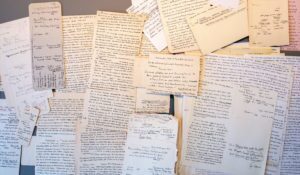
James Mellaart (1925–2012) is one of the most dazzling researchers in Anatolian archaeology. Almost singlehandedly, he discovered the Neolithic in Asia Minor and first initiated and then conducted excavations at Beycesultan, Hacılar Höyük, and Çatalhöyük. In the 1950s and 1960s, Mellaart was considered the world’s most famous prehistorian. An archaeologically interested audience around the globe followed his successes in the field. Nothing Mellaart did was irrelevant – both researchers and laymen admired him for his pioneering work, the fact that he had the courage to draw sweeping conclusions, his enthralling, amply illustrated lectures, and the sheer endless series of gripping books showcasing his detailed first-hand knowledge.
Despite this, accusations abound that some of the alleged archaeological artifacts that Mellaart presented in the form of drawings could have sprung from his imagination. In 1959 Mellaart published the so-called Dorak Treasure: artifacts he claimed to have seen in a house in Izmir which soon afterwards could no longer be located. Three years later, Turkish newspapers launched a campaign against Mellaart, starting with an eight-column-wide headline, accusing him of having smuggled this treasure across the border. This was followed by police and scientific investigations. In the end, Mellaart was acquitted of the accusations of smuggling and stealing artifacts. Nevertheless, he lost the support of the British Institute of Archaeology in Ankara and thus the opportunity to work in the field – for life – because of a number of undiplomatic blunders.
Dealing with Mellaart tends to polarize people: one is either a great admirer or a foe, and the intensity of these emotions apparently increases with proximity. The closer scholars were to him, the more intrigued or horrified they were. As the 100th anniversary of Mellaart’s birth approaches, the number of people who knew him personally is dwindling. For upcoming generations of scientists it would have been virtually impossible to reach a balanced judgment on Mellaart’s credibility; the facts are just too garbled.
It is therefore something of a relief that now, some sixty years after the Dorak Affair, we have finally achieved clarity. A scientific evaluation of notes found last year concealed deep in Mellaart’s former study has just been published. The documents leave no doubt that the famous prehistorian lived in a dream world. For decades he tried to substantiate his lofty fantasies with invented Neolithic murals and translations of equally fictitious Late Bronze Age tablets – always insisting that these were his modest reflections on really existing prehistoric artifacts.
Mellaart kept absolutely everything
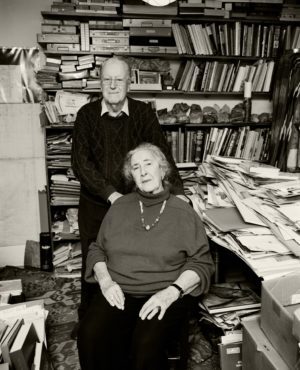
James and Arlette Mellaart in his study on the occasion of his 80th birthday. ©Charlie Hopkinson
James Mellaart was born in London in 1925, the son of an art dealer. When he was seven years old the family moved to Amsterdam because of the global economic crisis. His mother died there shortly afterwards. Her early passing apparently left a permanent mark on Mellaart’s character. In 1947 he left the Netherlands to study Egyptology at University College London, and never returned. After completing his studies, he received a position as a lecturer in 1964, and gave up teaching entirely only in 2005. Although Mellaart never had a doctorate himself, he did train doctoral students. He lived near Finsbury Park in North London for almost forty years, together with his wife Arlette, who came from the Turkish upper class. They had acquired and connected two small adjoining apartments there. Visitors raved about the flat’s cozy atmosphere, a place replete with valuable books and Anatolian kilims. On the walls hung the gold-framed decrees of Ottoman sultans, testifying to the special status of Arlette Mellaart’s family in Turkish society.
There was a remarkable disorder in Mellaart’s study, for the great explorer was a compulsive hoarder. He kept most of the projects, each in an A3 carton that was folded in the middle. Since Mellaart dealt with many hundred topics, the room was in places stacked waist-high with such folders. A photo taken on the occasion of the 80th birthday impressively documents this chaotic filing system. Mellaart did not part with anything: even junk mail and empty cigar boxes did not leave the apartment. That is how the fantasies to which Mellaart had devoted himself over the decades finally came to light. His study did not just contain the final results of his work as intended for publication (!), but also the elaborate drafts and tool kits that were required for their fabrication.
The “Sea Peoples” and the significance of Bronze Age Western Asia Minor
James Mellaart had fooled scientists – including me – throughout his life. Although we never met, we shared a common conviction. Independently of each other, we had both arrived at the conclusion that western Turkey must contain numerous, still-hidden Middle and Late Bronze Age sites. We both also believed that a large part of the Sea Peoples had their home in this region. Their attacks on the shores of the eastern Mediterranean shortly after 1200 BC contributed to the downfall of the Bronze Age cultures of the heroic era. Some of the mercenaries who supported the Hittite king Muwatalli (c. 1295–1272 BC) in 1274 at the Battle of Kadesh came from western Anatolia. The same names then appear in the Sea People inscriptions known from Upper Egypt, and are also found again in Homer’s Iliad among the allies of the Trojans during the Trojan War. The western part of modern Turkey must therefore have been densely populated around 1200 BC. And yet few Bronze Age settlements in this region have been excavated on a substantial scale to date.
This left a huge area of uncharted territory on the map of archaeologically known cultures. Legendary Troy, of all places, lies in this no-man’s-land, but the site was simply given a special status in archaeological paradigms. The empty space between the Mycenaean dominion in southern Greece and the Hittites in central Asia Minor is otherwise filled with what appears to have been uncivilized nomads roaming across the country in yurts and possessing no knowledge of writing. In fact, the only European scholar since Heinrich Schliemann who dared to launch a large-scale archaeological excavation of a Bronze Age site in western Turkey was James Mellaart. The site, called Beycesultan, is being dug up again today under the direction of Eşref Abay of Ege University in Izmir.
In 1995 James Mellaart heard about my book, “Ein neuer Kampf um Troia,” published the year before, in which I argued (like others before and after me) that a large part of the Sea Peoples must have come from Western Asia Minor. Mellaart then wrote me two letters of 22 pages in total with incredibly detailed information about the end of the Bronze Age. He said that he had extracted this information from translations of Late Bronze Age documents. At the time, colleagues advised me against following up on Mellaart’s letters, so I paid no attention to them for over twenty years. However, because of this trusting correspondence – and our shared beliefs about the importance of Bronze Age Western Asia Minor – I was granted the privilege of being the first scientist to review Mellaart’s estate.
In June 2017, Mellaart’s son Alan handed to me what his father had considered to be the most valuable asset in his inheritance. Naturally, I considered this a special honor, and during my first visit to the apartment in London would have never thought of asking permission to examine the rest of the estate.
The fabricated “Beyköy Text”
The documents I received were called the “Beyköy Text” by Mellaart. In 1993 he had mentioned in passing in three of his publications that such a text existed. From his letters, and thanks to a telephone conversation we had in 1995, I knew that these documents were English translations of allegedly Late Bronze Age texts said to have been found near the village of Beyköy in western Turkey at the end of the 19th century. The material included some one hundred typewritten pages of a text that is said to have been originally written on bronze tablets in Akkadian cuneiform script and Hittite language. Including various copies and manuscripts of unpublished evaluations, the whole pile I received from Alan Mellaart comprised about 500 sheets of paper.
The foundation board of Luwian Studies, a charitable non-profit organization dedicated to promoting the study of Bronze Age cultures in Western Asia Minor, decided to have these texts examined by various scientists over a five-year period. Additional indications of the authenticity of the documents would be welcome to justify the application of such substantial research funds. For this reason I asked Alan Mellaart to revisit his father’s study to search for additional evidence that the documents were indeed genuine. So, in February 2018, Alan Mellaart and I returned to North London to examine James Mellaart’s former study over the course of five days. At the very end, we came across an extensive collection of handwritten drafts of the “Beyköy Text.” Mellaart had placed the items he claimed to be the unpublished translations of Late Bronze Age tablets at the entrance to his study, clearly visible and appropriately labeled. The kits he had used to fabricate these documents, however, were kept well hidden. But not only that: I also found pieces of slate with pictorial carvings that were obviously sketches that Mellaart had published as reconstructed murals from Çatalhöyük. By this point there was no longer any doubt that Mellaart was a forger. The fact that he had carefully hidden the drafts hints at a sense of wrongdoing and suggests that Jimmy Bey, as Mellaart was called in Turkey, had also concealed them from his wife.
__________________________
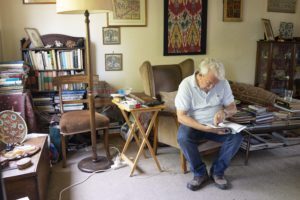
Alan Mellaart in his parents’ apartment in North London. ©Luwian Studies
__________________________
As the news of Mellaart’s falsification became public, several eyewitnesses came forward confirming our findings. I learned that Mellaart sometimes sketched artifacts that existed only in his imagination, even in the presence of friends. Tactfully, these companions turned a blind eye and had remained silent until today. Now we know that the allegedly “reconstructed” wall paintings from Çatalhöyük, which Mellaart had presented some twenty years after excavations were concluded, as well as the “Beyköy Text,” were pure inventions. Companions of Mellaart with whom I have been able to speak in the meantime also assume that the Dorak Treasure, which had caused a stir in 1962, was also invented, because the story follows the same pattern as the later cases. On the other hand the artifacts that were recovered in Mellaart’s excavations and which are now exhibited in the Turkish museums are without doubt genuine.
The large Luwian hieroglyph inscription remains enigmatic
In the pile of documents which Alan Mellaart passed on to me in June 2017, there were not just translations of allegedly cuneiform tablets, but also drawings of some Luwian hieroglyphic texts. Among these, one stands out, since the original must have been an almost thirty-meter-long inscription on limestone. According to Mellaart, this inscription was also found in Beyköy at the end of the 19th century; however, its research history is certainly invented. I sent the drawings of this hieroglyphic inscription to the Dutch linguist Fred Woudhuizen to ask for his opinion. He saw no reason to question the document’s authenticity and suggested a joint publication. Our work was published in December 2017 as a preliminary online publication in Talanta – Proceedings of the Dutch Archaeological and Historical Society, and is printed in the issue of Talanta that has just come out.
When word spread among colleagues that we were working on the publication of these Luwian hieroglyphic texts, we learned that the great inscription had already been shown and discussed in 1989 at an international conference in Ghent. Since then, there had been a consensus among insiders that this drawing was a forgery. In our paper, Fred Woudhuizen and I devoted five pages to linguistic arguments for and against forgery, but we came to the opposite conclusion. The now-released volume of Talanta contains another article by us with additional arguments that by and large point to the authenticity of the Luwian hieroglyphic inscription we call “Beyköy 2.”
During the past thirty years, since the inscription was first shown, important new insights have been gained in the field of Luwian linguistics. Thanks to these developments, the inscription can now be read much better. For example, it contains a sign for “great prince” which was not seen in a Luwian inscription until 2001. If Mellaart had forged the inscription, he would have invented a character whose existence was confirmed years later. It is thus more likely that Mellaart actually saw the Beyköy 2 inscription somewhere and that he had an opportunity to copy it. His unpublished translations and interpretations also show that he did not nearly understand its (grammatically correct) content.
Mellaart’s approach was always similar: in order to connect spectacular finds with his own models of interpretation, he filled the gap with invented drawings or texts. As part of his excavations in Çatalhöyük he had indeed discovered among many geometric murals one impressive landscape panorama. Twenty years later, he produced seventy additional ones! The “Beyköy Text,” which was also completely invented, may have been meant to link the Luwian inscription (Beyköy 2) with Mellaart’s theories on Bronze Age political developments. However, since the drawing of the Luwian hieroglyphic inscription was also retrieved from Mellaart’s “workshop,” this document will inevitably be treated with care until further notice, even if many linguistic arguments point to its authenticity. It would have been the find of the century – the account describing the end of the Bronze Age, composed by no lesser person than the Luwian Great King himself. Through his ruthlessness, Mellaart may have deprived archaeology of this important find.
___________________________

Allegedly “reconstructed” mural from Çatalhöyük. ©Luwian Studies
___________________________
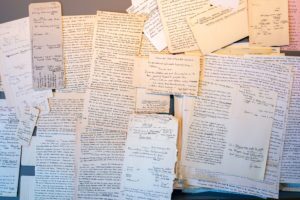
Notes and drafts that were required to compose the “Beyköy Text”. ©Luwian Studies
___________________________
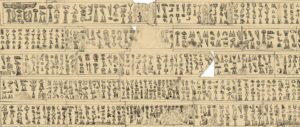
Large Luwian hieroglyphic inscription (“Beyköy 2”) retrieved from Mellaart’s estate. ©Luwian Studies
___________________________
One question remains: Why, for half a century, did the world’s most famous archaeologist invent artifacts that never really existed? The unpublished manuscripts in Mellaart’s estate reveal a feeling of superiority. Mellaart enjoys the importance of his own inventions for archaeology. His fantasies were designed to underpin his professional ideas about Anatolian prehistory with “facts.” They also brought him back into the limelight – confirming ideas that he had always claimed to boot. It was, it turns out, a juvenile prank he apparently played throughout his life. His concepts and ideas may not have been all that wrong; the evidence, however, was forged.
_____________________________
Source
All contributions to the 50th volume of Talanta – Proceedings of the Dutch Archaeological and Historical Society, which has now been published, are dedicated to documents from Mellaart’s estate. This paper is a summary of the almost 60-page article “James Mellaart’s Fantasies,” which is available online as a PDF for free download from https://luwianstudies.academia.edu/EZangger.


